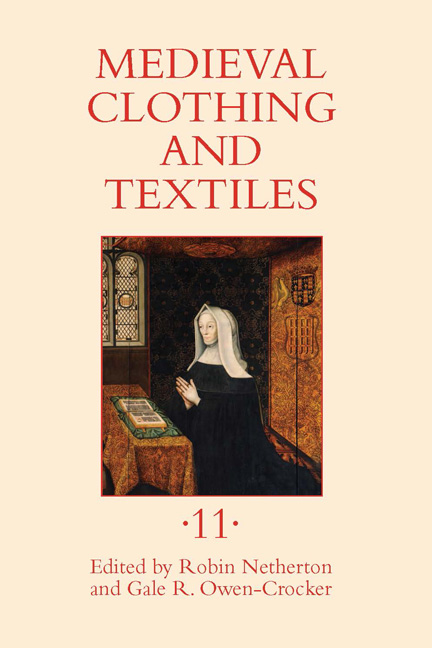Book contents
- Frontmatter
- Contents
- Illustrations
- Tables
- Contributors
- Preface
- 1 Production, Quality, and Social Status in Viking Age Dress: Three Cases from Western Norway
- 2 The Effect of Spindle Whorl Design on Wool Thread Production: A Practical Experiment Based on Examples from Eighth-Century Denmark
- 3 The Shirt Attributed to St. Louis
- 4 Angevin-Sicilian Sumptuary Statutes of the 1290s: Fashion in the Thirteenth-Century Mediterranean
- 5 The Devil on My Tail: Clothing and Visual Culture in the Camposanto Last Judgment
- 6 “Transposing þe shapus þat God first mad them of”: Manipulated Masculinity in the Galaunt Tradition
- 7 Textiles and Dress in the Household Papers of Lady Margaret Beaufort (1443–1509), Mother of King Henry VII
- 8 “Like two artificial gods”: Needlework and Female Bonding in A Midsummer Night's Dream
- Recent Books of Interest
- Contents of Previous Volumes
4 - Angevin-Sicilian Sumptuary Statutes of the 1290s: Fashion in the Thirteenth-Century Mediterranean
Published online by Cambridge University Press: 05 December 2015
- Frontmatter
- Contents
- Illustrations
- Tables
- Contributors
- Preface
- 1 Production, Quality, and Social Status in Viking Age Dress: Three Cases from Western Norway
- 2 The Effect of Spindle Whorl Design on Wool Thread Production: A Practical Experiment Based on Examples from Eighth-Century Denmark
- 3 The Shirt Attributed to St. Louis
- 4 Angevin-Sicilian Sumptuary Statutes of the 1290s: Fashion in the Thirteenth-Century Mediterranean
- 5 The Devil on My Tail: Clothing and Visual Culture in the Camposanto Last Judgment
- 6 “Transposing þe shapus þat God first mad them of”: Manipulated Masculinity in the Galaunt Tradition
- 7 Textiles and Dress in the Household Papers of Lady Margaret Beaufort (1443–1509), Mother of King Henry VII
- 8 “Like two artificial gods”: Needlework and Female Bonding in A Midsummer Night's Dream
- Recent Books of Interest
- Contents of Previous Volumes
Summary
In July 5, 1290, a sumptuary law aimed at regulating consumption during the miseries of the long Sicilian war was promulgated in Naples by the vice-regents of the reigning king of Sicily and Naples (together known as the Regno), Charles II, prince of Salerno. These two Angevin-French “justiciars” were Robert II, Count of Artois, and the king's son and heir apparent Charles Martel (Carlo Martello). The statutes were promulgated at least two other times in Provence and the Regno: We know of instances in 1292 and 1293, and other documents may have been lost, as the Neapolitan archives have suffered extensive damage. The Latin of this document bears the imprint of the northern French language and style of Robert as well as the Neapolitan and Mediterranean milieu of Carlo Martello. Its prohibitions offer insight into practices of consumption in the international crossroads of the Mediterranean in the late thirteenth century, where the next generation of Charles d'Anjou's French, Provençal, and Angevin courtiers mingled with local Neapolitans, Romans, and Sicilians while facing hostile takeover by the Catalans and Aragonese. The prohibitions have been mentioned by a few scholars, but they have not been scrutinized closely or translated into English. A close reading of the law's clothing prohibitions can shed light on what the elite men of the 1290s sought to wear, what they might allow the women of their households, and what was targeted for cost-cutting during a military crisis. In the second section of this essay, I will consider how these regulations fit into the broader context of thirteenth-century sumptuary legislation, and whether French, Iberian, or Roman laws were more influential as models. My broader question is this: Do these statutes constitute evidence of a culture of fashionable consumption at this time? I will argue that they do. Sumptuary laws are worth studying in the light of fashion theory. For one, they are directly related to consumption patterns that were already occurring.
- Type
- Chapter
- Information
- Medieval Clothing and Textiles 11 , pp. 79 - 98Publisher: Boydell & BrewerPrint publication year: 2015



